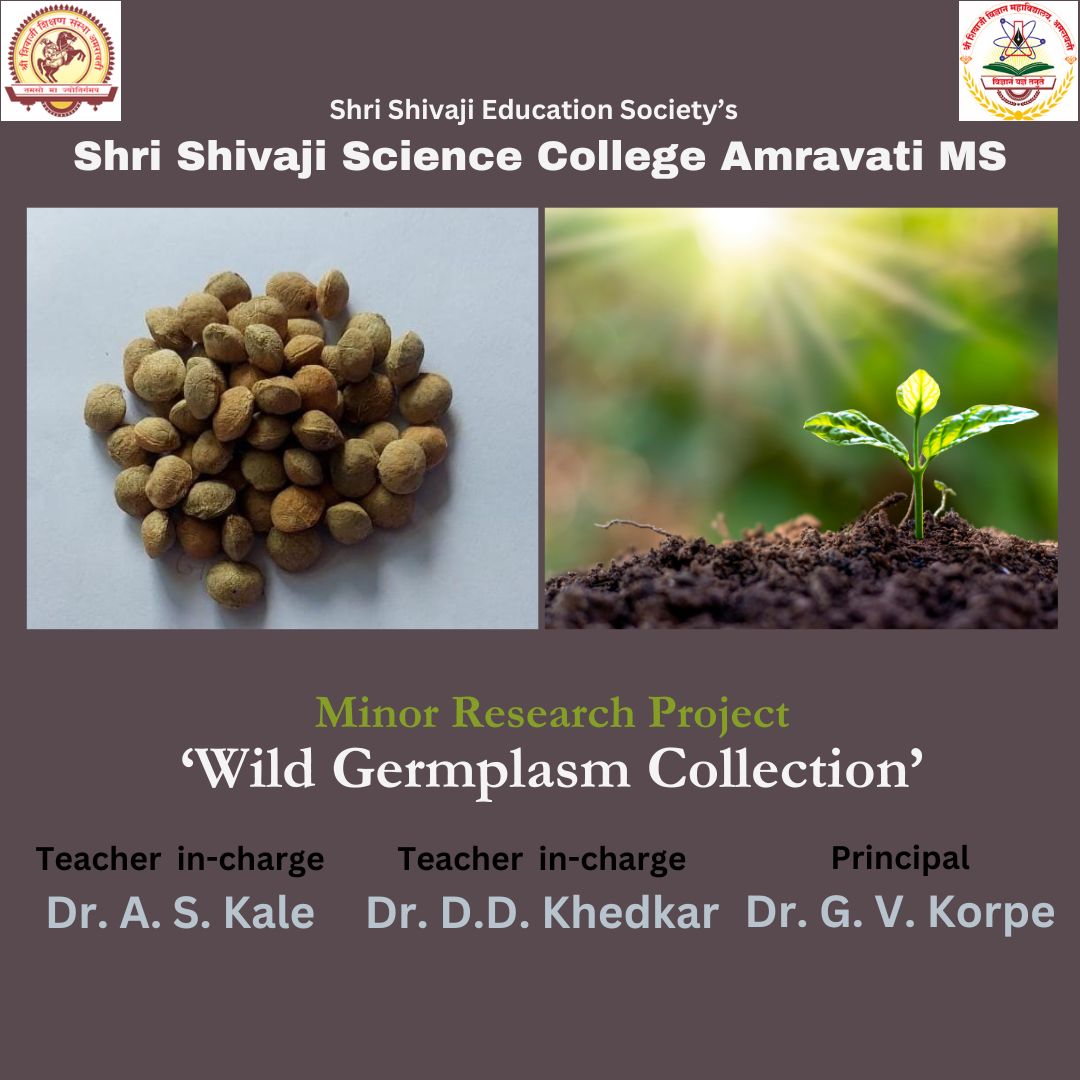SHRI SHIVAJI SCIENCE COLLEGE, AMRAVATI
DBT STAR COLLEGE PROJECT ACTIVITY
ACTIVITY REPORT

Collection and Conservation of Wild Germplasm from Amravati and Nearby Forest Regions
Activity Dates: 10/09/2024 to 25/09/2024
Type of Activity: Minor Research Project
Organizing Department: Department of Botany & Bioinformatics
Program Coordinators: Dr. Ankit S. Kale
Head of the Department: Dr. D. D. Khedkar
External Collaborator (if any): -
Objectives:
- To involve BSc 3rd year students in practical, field-based conservation activities.
- To collect wild germplasm from the Amravati and nearby forest regions.
- To store and preserve the collected germplasm.
- To raise awareness among students about the importance of biodiversity and germplasm conservation.
- To prepare a small seed bank in the botany department.
No of Beneficieries: 05
Classes Involved: BSC III
Venue of the Activity: Shri Shivaji Science College, Melghat forest region, Washim, Ner, Darwa
Activity Report:
Introduction and Background
The project, titled ‘Collection and Conservation of Wild Germplasm from Amravati and Nearby Forest Regions,’ was initiated as part of the DBT Star Project by the Department of Botany, with active involvement of BSc 3rd year students. The primary aim of this research-based project was to contribute to the conservation of biodiversity by identifying, collecting, and preserving wild germplasm from various regions around Amravati. As part of the project, students were engaged in a range of practical activities, including field visits, collection of plant material, documentation, and conservation techniques. The project was led by Dr. Ankit S. Kale, Assistant Professor of the Department of Botany, who acted as the teacher in charge, ensuring the effective involvement of students and adherence to scientific methodologies.
Biodiversity conservation is a critical need in the face of increasing habitat destruction, climate change, and loss of species due to anthropogenic activities. The wild germplasm, often overlooked in favor of cultivated crops, holds significant genetic potential, including traits such as disease resistance, drought tolerance, and environmental adaptability. Such traits can be used in crop improvement programs, making wild germplasm an invaluable resource for sustainable agriculture. This project thus emphasized the importance of protecting these genetic resources by documenting, storing, and conserving seeds and other plant parts collected from wild species.
Planning and Preparatory Work
The initial phase of the project involved thorough planning to ensure that the fieldwork and collection process would be successful. Key activities in this stage included the identification of target areas for germplasm collection, the preparation of necessary tools, and student orientation.
Site Selection: A variety of regions in and around Amravati were shortlisted for the collection activities. The areas were chosen based on their plant diversity and the presence of unique or rare species. Specific locations included Washim, Amravati, Chikhaldara, Melghat villages, and Ner, all known for their rich biodiversity. These sites were selected to ensure a diverse range of plant species could be collected.
Tools and Equipment: To facilitate germplasm collection, a range of tools were prepared, including seed bags, plant cutting tools, labels, GPS devices, and documentation materials. The students were trained on the ethical guidelines of germplasm collection, emphasizing the need to avoid over-harvesting and ensure the protection of natural habitats.
Field Visits and Collection Process
Field visits formed the core component of this project. Under the supervision of faculty members, BSc 3rd year students conducted multiple visits to the pre-selected regions. Each field visit was carefully planned, with students assigned specific roles to ensure efficiency in the collection process.
Collection of Germplasm: The students collected seeds, cuttings, and other plant parts from a wide variety of species. Local guides, including forest department personnel and villagers with indigenous knowledge, assisted in identifying valuable plant species that might otherwise have been overlooked.
Documentation: The process of germplasm collection involved meticulous documentation. Each collected sample was carefully labeled with relevant information, including the species name (where known), the date of collection, the location (GPS coordinates), and environmental conditions.
Seed Preservation and Storage
Once the germplasm was collected, the focus shifted towards its preservation and long-term storage. The collected seeds and plant parts were brought to the Department of Botany for further processing.
Initial Cleaning and Drying: The first step after collection was the cleaning and drying of the seeds. Seeds were cleaned of any debris or dirt and then dried to ensure they would not rot during storage. Special care was taken with seeds that are particularly moisture-sensitive, such as those from tropical or forest species.
Storage Protocols: Following cleaning and drying, the seeds were stored in properly labeled containers. Each container was marked with the species name, collection site, and date, ensuring that future researchers or students could trace the germplasm's origins. The seeds were stored in a cool, dry environment to prolong their viability, following the recommended protocols for long-term germplasm storage.
Student Involvement and Learning Outcomes
One of the core objectives of this project was to involve BSc 3rd year students in hands-on conservation activities. Throughout the project, students took on a range of responsibilities, from planning field visits to collecting germplasm and documenting data.
The experience provided students with practical skills in fieldwork, species identification, data recording, and conservation techniques. Moreover, it helped them understand the importance of biodiversity in a tangible way. Many students reported that the project deepened their appreciation of the intricate relationships between different species and the ecosystems they inhabit.
Outcomes:
- Successful Collection and Documentation of Wild Germplasm
- Establishment of a Germplasm Seed Bank
- Enhanced Student Knowledge and Skills in Biodiversity Conservation:
- Increased Awareness of the Importance of Biodiversity and Conservation:
- Enhanced student involvement and understanding of biodiversity and germplasm conservation techniques.
Photos:
 Students With Stored Viable Germplasm of Plants |  Collection of Germplasm at Shri Shivaji Science College Campus Amravati |
 Learning Methods of Collection and Storage of Germplasm |  Documentation |
 Collected Seeds of Different Plants |  Glass Bottles ready for Packaging |
Attendance Sheet:
 |